44.
The Book of the Life of the Ancient Mexicans
[The following account and pictures are taken from an ancient manuscript or
codex which bears on the original sheets the following caption: "Book of
the life which was led by the Indians of former days, with an account
of the superstitions and evil performances which they believed in
and observed." The manuscript consists of seventy-six colored
pictures, apparently the work of native Aztec draughtsmen, accompanied by
explanatory notes in Spanish. The manuscript in this form was known
as the Codex Magliabecchi and was preserved in Florence. A facsimile of
it, in color, edited by Zelia Nuttall, but not translated, was published
by the University of California Press in 1903, under the title "The
Book of the Life of the Ancient Mexicans, part I." In the original
manuscript no author is mentioned for the explanatory notes in Spanish, but
these have been identified by Mrs. Nuttall with portions of a "Cronica de
las Indias" or History of the Indies, that is America, written by
Cervantes de Salazar.
Twelve of the illustrations in this work are here reproduced minus
color. The Spanish text is given complete in translation or close
paraphrase, except for the first sixteen pages of the manuscript which refer
to blanket designs and the calendar. The numbers heading the sections
of text refer to the paging of the pictures in the original. A few
remarks as to pronunciation and order of the illustrations have been omitted
from the translation; and occasional explanatory words or phrases
supplied by the translator are enclosed in square brackets. The translation
is the work of T. T. Waterman.]
17.
This festival the Indians call Xilomaniztli. The Mexicans [of
Tenoch-titlan] and certain others call it Alcavalo . . . ., for the
reason that at this time the fishermen "leave off"; that is to
say, leave the water. They call the festival Xilomaniztli because
they paint it [the image of the god] with ears of maize in its fist. These
ears before the grain hardens are called xilotl, from which
is derived Xilomaniztli, that is to say, "he holds
xilotes in his hand." In this festival they sacrifice boys. The
demon is called Tlaloc in Mexico. They drown these boys in
canoes. . . .
18.
This figure represents the festival which the Indians call
Tlacaxipeualiztli . . . ., which means "he skins me and you
shall eat me"; because in this festival they kill one whom they call
Totodeci or Xipeu. . . . He is tied to a wheel of stone,
which they call tamalacatli. When tied to this, they give him a
club in his hand, very bravely. Then another
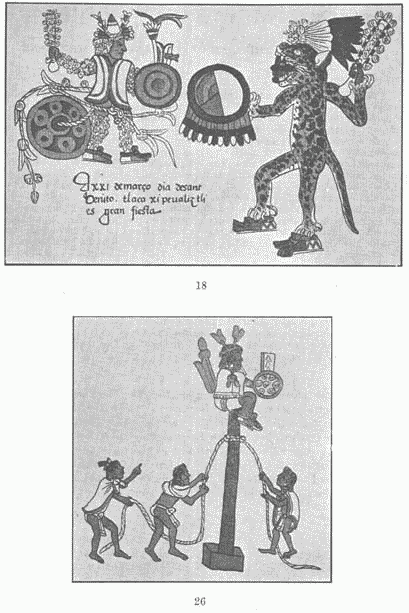
Indian, covered with the skin of a tiger [ocelot] goes against him, also
holding in his hand a club. This second club is set with pointed objects.
Then they give it to each other until the one who is tied up is killed.
Then he skins him, and later, dressed in the skin of the dead man, he
dances before the demon, whom they call Tlacateu Texcatepocatl. He
who has to fight fasts for four days, and exercises for many days
previously to fighting with the tied-up person. He also offers many
sacrifices to this demon, so that the demon may give him victory. . . .
The date is the twenty-first of March, the feast of St. Benedict. It is
a great festival.
19.
This is an illustration of the festival of a [female] demon which the
Indians call Toçoztli. The demon for whom they celebrate this
festival is named Chalchuite because they put around its neck a
necklace of emeralds [jade or turquoise], which they call chalchuitl;
and they call those whom they sacrificed in this festival
tlacateteuitl. These were children. They offer much copal [incense]
and [maguey] paper and stalks of maize. Moreover in this festival they
sacrificed an Indian woman, and this woman tied a fillet around her hair in
simulation of the demon, who is represented in the fashion shown on the
opposite page. It is worthy of note that in this festival small children
were sacrificed, and female children, and also newly born infants. They
also bestow names on them, as we Christians do in baptism. This point is
mentioned in regard to one of the festivals which are taken up in later
pages, but the ceremony is restricted to these two occasions. They also
gave food to their elders. He who was once offered in this way they never
offered again. They called this festival Tlicoquepipiltontli,
and they gave the demon, whom they call centeotl, tamales and
other things to eat. . . .
20.
This festival they call Gacitocoztli because they offer before
the demon stalks with leaves (consisting entirely of maize) which among
them is called tuctli. In this festival they offer to the demon a
great deal of maize and tamales mixed with beans. In this festival boys at
dawn place in their temples such loaves of maize. The demon to whom they
celebrate this festival is called Ocenteutl, that is to say, deity
of the maize. In this festival fathers offer to the demon children at the
breast, as in the sacrifice. They invite their elders to feast. This is
called tecoa which means in their language
"sacrifice". . . .
21.
This is the festival which the Indians call Toxcatl. . . .
It was a great festival, because the demos whose rites were celebrated in these
ceremonies is Texcatepocatl that is, Smoking Mirror. He was the
greatest of the greater gods whom they reverenced. They also give him as
another name Titlacauan, that is to say, "of whom we are
slaves." In his honor they perform dances and sing songs, and offer
roses, and bring labrets and feathers, which are the things they value
most. In this festival they cut their tongues and offer the flesh [blood]
to the demon. They also make tamales of the seeds of the blite and of
maize, which latter they call the body of their god. They eat these tamales
with a grand celebration. . . .
22.
This is the festival which they call Eçalcoaliztli, that is,
"eating eçatl," which refers to a custom of eating
some cooked maize. The demon who is honored in this performance is
Queçalcoatl that is, "serpent with beautiful plumes."
This demon was god of the breeze, and was said to be the friend or
superior of another whom they called Tlaloc and brother of another
whom they call Xubotl, he whom they set up either in a painted or a
carved figure over their games of chance. He is also
"Queçalcoatl" when he is invoked. In this feast the
Indians cook much maize and beans (which they call poçole).
In the paintings this god is represented standing on a mat of rushes.
In this festival the Indians offered sacrifices of their sex organs, which
rite they called motepulico; that is, "this filth
sacrificed." Some say that they do this in order to induce their god
to give them offspring. In this festival also the maçaguales
[serfs] took coas (or sticks with which they used to dig their
maize) at the foot of the wall and each one, great and little, placed on it
several leaves of maize, that is, of poçole or cooked maize. In
this festival they offered to the demon male children, recently born, which
they call teyeoque. This is a ceremony which they have. In this
ceremony they invite their elders to feast, as Christians do at the baptism
of their children. . . .
23.
This festival is called Tecuilhuitl in which the young men carry
on their shoulders the demon, dressed to represent a parrot and in a litter
lined with leaves and stalks of maize, playing flutes and other different
instruments before the demon. In his hand they place a scepter of feathers
which they call yolotopili or "heart staff." The demon
whose festival is represented here is called Tlacopilli, that is,
"excellent lord". . . .
24.
This festival is called among the Indians Huei teculhuitl and the
demon to whom they celebrate this festival is called Uztocivatl.
They sacrifice in this festival a woman whom they call Xilone. . . .
that is, Young Corn Ear, for in this festival, in distinction to the
one just mentioned, they employ such unripened ears of corn, called
xilotl, which they offer before the demon on this day. . . .
25.
This festival is called Michaylhuitl, that is, "festival of
the dead," because in it they celebrated the rites concerned with
their dead children. They danced with profound grief, and sacrificed boys.
The demon whom they honored in this ceremony was Titlaciuan that is,
"of whom we are slaves." He was the same as Tezcatipocatl,
or "Smoking Mirror," except that they paint him in this
picture with different colors, and according as they give him different
names. Others call this festival Moxuchimaca, because in it they
drape garlands of roses on the demon. To this Tezcatepocatl are
dedicated the teucales [pyramid temples]. Him they call
Tlacuchcalcatl and Uicinauatl . . . . that is, "now
comes his [divinity]." In reverence of him the principal Indians
assume these names. . . .
26.
This figure represents a festival which the Indians call Huei mical
huitl, which means "great festival." Others call it Xucutl
gueci, because in it they set up a tree, very tall, on the top of which
is seated an Indian. Other Indians knock down from his perch this one who
is seated above, going up and clambering on several ropes which are tied to
the tree. They take some tamales which they call teuçoalle,
that is, "bread of god." Trying one of them to outdo the
other, they knock him to the ground, where the Indians kill him in order to
partake of him as "holy bread." Afterwards they throw into the
tire that which they have knocked off of the tree. They put the head in a
bath, so that although it be baked, no harm shall happen to the hair or the
head until later they eat it baked. The skinned head they set up on another
body and dance with it before the demon, called Hucteutl, to whom
the festival is dedicated. . . .
27.
This illustration represents the festival which the Indians call
Uchpaniztli, that is to stay "by sweeping," because in it
they place in the hand of the demon whom they call Toci (that is,
"our eagle") a broom. In this festival they sacrifice Indian
women to the cues [temples] which stand in front of the highways.
They have great dances and drinking bouts. The Indian women whom they
sacrifice, these they skin, and other women dress in their hides to dance
before this demon. . . .
28.
The Indians call this festival Pachtli, that is, certain
brownish plants like tangled cords which the Indians collect from the rose
trees, because they grow very long and large. In these dances they make
garlands of this plant, for the head. The demon whom they celebrated in
this festival was Teçcatepoca, that is, "Smoking
Mirror." They sacrifice Indians, throwing them alive into the fire.
Some escape and run away. The place of sacrifice is up some high steps, up
which those whom they have to sacrifice pass up, right to the top. For this
reason others call this festival Teutleco, that is to say,
"going up to the god." In this festival they celebrate also
another demon, whom they call Ome tuchtli, who is the god of drunken
debauches. . . .
29.
This festival the Indians called Hue pachtli; that is to say,
"Great Herb" (of the sort which was mentioned in the account of
that other festival, just above). They say this was a festival of the
pueblo, and for that reason they paint a hill and over it a snake, which
they cover with tamale dough which they call coaltica qui pepechoa.
This demon was called Suchi-queçale. They also sacrifice an
Indian woman. On this same day they celebrated another festival which is
called Pilauana, that is, "drunkeness of the children";
because in this festival the boys dance with the girls. Then they give each
other to drink until they intoxicate themselves and some of them commit
with one another foulnesses and fornications. These children were already
little chieftains, of the age of nine or ten years. This debauch did not
occur everywhere, but only in the tlalhuicas, that is, the level
irrigated plains, where the sun is hot. . . .
30.
The Indians call this festival Quechule, that is,
"arrow," (which they call in their own language mitl)
because in this festival they make many arrows. With these arrows and
with bows they dance on the day in question before the demon, whom they
call Mizcoatl. From the name of this demon certain important men in
the pueblo are themselves named, a fact referred to above. Then on another
day (the following one) they go hunting with these arrows. For four days
beforehand they eat only bread and water, abstaining from chile-peppers and
all other foods. Once a day towards evening they [go] to the demon. They
represented the demon as having his eyes blackened, with a thing like a
white stick through the nostrils, and in his hand an ornamented staff like
a sickle, which they call Mixcoatl xonoquitl. . . .
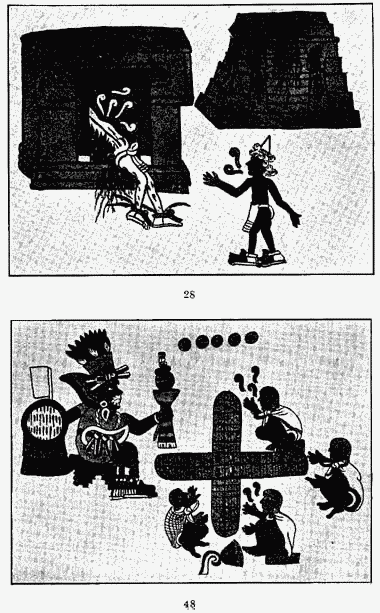
31.
The Indians called this festival Panquezalizti which was the
greatest festival of their year. In this they celebrated to the demon whom
they called Vicilopoxtli who was of their gods the friend of
Tezcatepocatl. This festival is called Panquezaliztli because
in it they place on the head of Uicilopochtli a broad affair which
they call panitl, of a blue color, (which latter the Indians call
texutli). They equip the image also in colored paper, and
with a shield of leather in his hand. In this festival there was sacrificed
in Mexico a huge crowd of people of those whom they had seized from
Tlascala and Guaxocingo. . . .
32.
This festival was called Atemuztle, that is, "the coming
down of the water"; because in it they ask their god for water so they
might begin planting the maize. The demon who was honored in this festival
was called Tlaloc, that is, "with earth"; because his
influence was in that which germinates in the ground. The caciques and
lords observed this festival for the most part, and these lords sacrificed
slaves on the elevations. They also offer feathers, and they drown in the
water children, that the god may give them rain.
33.
This festival the Indians call Tititl. . . . The demon whom they
celebrate in this festival is called Çiuacoatl that is, Snake
Woman. In this festival they celebrate the feast of the dead. Their
festival was celebrated after this fashion. They took a faggot of
ocotl, which in Spain is called pitchwood and they dress it up in a
mantle or gown. If the dead person had been a woman, they dressed the
faggot in her petticoats and they put in front of her vessels or cooking
pots and other household utensils. If the dead person had been a chief and
a valiant man they dressed the faggot in a rich mantle and waist-cloth and
labret and a handful of pitchwood. The labret which they call
teçacatl was made of amber or crystal. This they are accustomed
to wear, when they drink or dance in the ceremonies, hanging down from a
hole which they have pierced above the chin through the lip. And they also
put on the image the dead man’s plumes, which he wore tied to his
occiput, and which they call tlalpiloni, and in addition, much
perfume. Then they seated the image on a sleeping-mat above his equipal,
and they put there much food and they invited the principal men there.
Then they put fire to the pitch-wood and everything which they had put
there burned up. This memorial which their sons or relatives performed
every year in their honor, they called Quixebilotia, which means
that they set up his figure or memorial.
34.
This festival governs twenty-five days according to the Indians. It is
celebrated on the feast of San Gilberti the Confessor. The demon in whose
memory this festival is celebrated is called Xuctecutl. In the
festival they sacrifice two Indians, one of whom is called Ixcocauque,
and the other Comulco. They have tremendous drinking bouts in
these areitos, or dances. This festival is called Ixcalli. . . . It
fell on the fourth day of February. In this festival nobody ate anything
except gruel made of the blite, and bread. This however is only in
Mexico.
Izcalli, on the fourth of February, the last festival of the year
according to the reckoning of the Indians, governs twenty-five days.
It falls on the feast of St. Gilbert the Confessor.
35.
This festival is one of the extravagant observances. It is called
Xuchitl huitl, that is, Feast of the Flowers. In this festival the
young men (in Aztec telpochitl) perform a dance, each one ill
his own barrio. This fiesta falls twice in a year, or, to speak more
exactly, every two hundred days. In this way it may occur once in a given
year, and twice in other years. For this festival they save up the shells
of the eggs of domestic fowls, sacking up each hen. Then in the dawn they
pour them out along the roads and streets ill celebration of the mercy of
their god in having given them fowls. The demon whom they celebrate in this
festival is called Chicome xuchitl that is to say, "Seven
Flowers."
36.
This is a festival which the Indians call Ce xuchitl, that is the
festival "One Flower." This falls twenty days after the one just
mentioned. In it the same performances are held as in the preceding
one.
37.
This festival is the festival of a demon whom they believe in here,
called Papaztac, one of the four hundred drunken gods whom the
Indians believe in. They were given different names, but were referred to
all together as the totochti or "Rabbits."
When the Indians had their corn cut and gathered, they had drinking bouts
and danced invoking this demon. And others of the four hundred, whose
pictures are on following pages, they did the same.
38.
This is an illustration of a grand debauch which a pueblo called
Tepuztlan celebrates as a ceremony. The custom was that when any
Indian dies drunk, the others of this pueblo held a grand ceremony, with
axes of copper, which they use for cutting wood, in their hands. This
pueblo is part of Yauhtepec, [and its inhabitants were] vassals of
the Marquis of the Valley.
39.
This demon is one of the four hundred demons of drunkeness already
spoken of. He is called Yautengante.
40.
This is another of the same series (that is, of the drunken gods). His
name is Tultegate.
41.
This was another of the four hundred whom the Indians called gods of
wine and of drunken people, namely, Poctegatl, because it was like
medicine to them, this wine was.
42.
This demon is like those just mentioned. He is called
Tezcaçongatl. . . .
43.
This demon is called Tlaltegagoa, in which ceremony (the one
celebrated to this demon) there goes in front an Indian dressed in the
skin of a female monkey, for which animal their word is
cuçumate.
44.
The accompanying demon is called Colhuaca cuigatl.
45.
This accompanying demon was called Totul tegatl.
46.
The accompanying demon was called Mayavel that is,
"Maguey" because the juice which came out of the maguey was
intoxicating and they dance.
47.
The following demon was called Tilichuçi.
48.
This is a game which the Indians play. They cull it patole. It is
like a game of dice, played upon a painted mat, as in the accompanying
pie-ture. Those who are masters at this game invoked this demon, whom
they call Macuilsuchitl, that is, "Five Roses."
They invoked him in order that he should give them a winning day.
49.
This demon is one of the gods which the Indians believe in. His name was
Queçalcoatl, or "Feathered Serpent." He is considered
the god of the Breeze. They represented his face from the nose down as
wood, in the form of a trumpet, through which blew the wind, which they say
was from this god. On top of his head they place a cap of tiger skin, and
from it there issued as a crest, a bone, to which were attached many
feathers of ducks native to the country, called xumutl; and last
of all there was attached by its beak a bird which they call vicicili
[humming bird]. When this festival was observed the Indians offered
to this idol ayutli, certain (melons of the country). Of this one
they say that he was the son of another god whom they call Mictlan
tecutli who is lord of the place of the dead; and son also of another
idol which they call Xulutl, that is, a sort of bread which they
have, made of blite and maize.
51.
The accompanying figure represents also one of the four hundred gods
which they call gods of the drunken. They call him Yxdilçi.
52.
This demon they have as a god. He is called Techalotl which is
the name of an animal like a little skunk. These animals live between the
rocks in holes. This is not one of the four hundred drunken gods.
53.
This illustration is the figure of a demon whom the Indians have for the
god of the place where the dead went. This place they call Michtlan,
that is, "place of the dead." This word certain interpreters
have appropriated for the idea "hell." This is a great
mistake, for the Indians had no word for that idea. Thus when the Friars
preached to them that if they were ill-observers of the faith of God,
"they would go to Mictlan," it does not matter to the
Indians, because in any case they expected to go there. Rather than to use
the word Ichatlaca teculotl, that is "to go to the house of the
Devil," the Indians say merely Mictlan tecutl, or "Lord of
the Place [of the Dead]."
54.
This illustration is an illustration of what occurred when a ruler or
principal man dies; namely, they wrapped him in a shroud seated on his
haunches, as the Indians are accustomed to sit. And his relatives gather
much wood. Then they incinerate him, as the ancient Romans were accustomed
to do it, in the time of their heathenism. Before him they sacrificed one
or two slaves, so that they could bury them with him, after they had burned
them. Also in certain parts of the country where so doing was the custom,
there were buried with them their women; for they said that yonder these
women were to wait on them. They buried each man’s treasure also, in
cases where they have any.
55.
This illustration is an illustration of the same observance: The dead
man’s children and relatives wailed for him. They also gave him
cavavatl [cacao, chocolate] for his journey. The figure which
represents this is the second of the two on the following page.
The first illustration represents the place where they buried the dead.
Accordingly here are the remains.
56.
This picture represents the observances held when a merchant has died.
They cremate him and bury him with his effects, and tiger-skins and
anything else he possessed, putting around him in a circle the guitaras and
gold and oyeles and fine stones which they had; and feathers, as
though in Mictlan (which is their name for the place of the dead) he
might have use for this property.
57.
This figure represents the observances held when a young man died. That
which they set out for him was tamales and beans. They also gave him to
carry on his back a load of paper if he had it. He also had tied on like a
plume a paper, which they call amatl. But with all this burden or
heap of things he was to go to meet the Lord of Mictlan.
58.
This is a staff which has on it a drapery, like the Manga de Cruz like
those which they make here of feathers. The device was among these Indians
used like a banner, which they set up in front of the temple when they
sacrifice. It is the first thing in the following picture. The rest of the
picture represents the scene when they sacrifice Indians—how
they
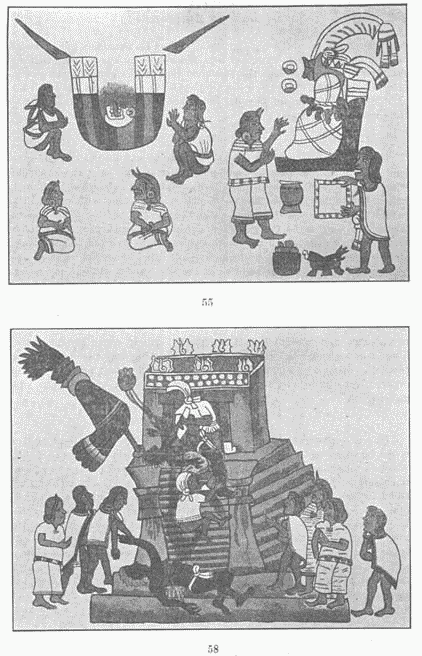
take the victim up to the top and throw him on his shoulders upon a
stone and cut out his heart. Another man holds him by the feet so that he
shall not struggle. It was the tlamacaz, that is the chief of the
executioners, who killed him. In order to do this, he tied up his head
and his hair with a white mantle, in order to cut out the heart and anoint
with it the snout of the demon.
59.
This picture is when they elevate someone to be a lord or official, or
to hold some honorable office in their state. Let us note what they did
first when they elevated a man to be a lord of this sort. He stood
unclothed, naked, before certain ones who spoke and said how, and with what
solicitude, be should exercise his office. Him they placed in front of
the demon whom they hold to be the god of fire, called Xucteutl,
where they offer sacrifice of incense which they call copale.
They give him a new name, and he loses the one which he formerly had.
They order him to sleep one night to the middle of the night or of the sky,
naked, without any covering. They gave him as insignia to denote his
office a mantle and a receptacle of yellow gourd with colored streamers
through its handles, and like a burden they hung it around his neck. They
place him thus burdened before the demon mentioned above, where he
promises faithfulness in his office, and to serve him [the divinity] and to
sweep his courtyard, himself or his subjects. He fasts four days, eating
only bread and water toward evening, this and nothing else. Every time that
anybody, being ordered, goes anywhere, they give him drink, to him and to
those who go with him.
60.
This is a representation of what happened when the Indians held a
memorial ceremony for their dead, in the festival which they call
Tititl. As was said (in speaking of this festival on a previous
page) concerning the figure of him for whom the observances were held, it
was like that which is herewith represented. . . . They put in his nose an
affair of blue paper which they call yacaxuitl, that is, "plant
nose." Back of his face which is of wood they filled up with chicken
feathers, the small white kind. For a crest they put a stick covered with
paper, which they call amatl, and on the head for a headdress they
put some plants which they call malimali. From the occiput there
hangs down another crest which they call pantolole [maize-flag],
which is made of paper. Through his shoulders the figure was stuffed with
papers, and he had a lip-plug and around his neck there was hung as an
ornament a little animal which they call jilotl. The ornament they
call xilocuzcatl [maize-jewel], but it was made for this ceremony
out of painted paper. There was also a staff
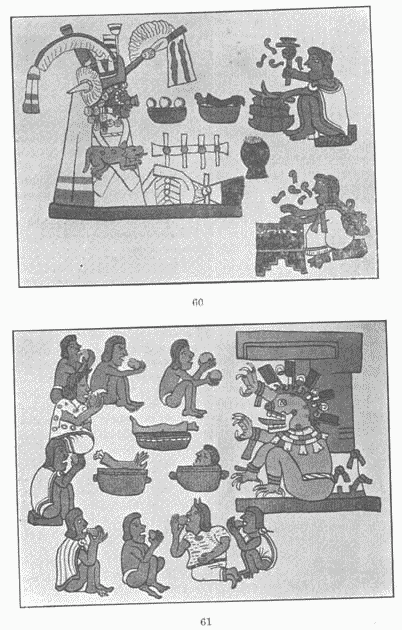
covered with paper in the form of crosses. Below there was a load of
sheets of paper, and cacao for food. In front there were two or three or
more Indians, who were seated and sang, and beat a kettle-drum which they
call vevetl. . . . This they did every year up to four years after
the death of the deceased, and no more.
61.
In this picture is shown the abominable custom the Indians had, the day
they sacrificed men to their idols. Namely, right there before the demon
whom they call Mictlan tecutl (that is, lord of the place of the
dead, as described in another place), they set out many cooking pots of the
human flesh [just mentioned] and give it out and serve it to the important
personages and officials and to those officials called tamagatl
[tlamacaz, sacrificing priest] who serve at the temple of the
demon, and these in turn share that which has been given them with their
friends and relatives. They say that it tastes like the pork which they
eat today, and for that reason pork is much desired among them.
62.
This is a minor sacrifice consisting of incense, or paper with blood,
which the Indians offer to their gods. Here it ought to be observed that
every five [days] they hold a cue or place of sacrifice, so that all
can make offerings there in common. In addition to the above small [place
of] sacrifice they have every twenty days a greater one which was
dedicated to an idol of one of their gods for whom they exhibit devotion.
Each barrio has another idol. They say it was he who guarded the barrio. To
him they run with their petitions in time of necessity. Here it must be
noted that no one asks except for temporal things; for example, for food or
(long) life. This is as far as their prayers go. On the day on which the
festival of this idol falls, the people of that particular barrio offer him
solemnities. The other barrios do not.
63.
This is a representation of a goddess which the Indians have, called
Atlacoaya, that is, dark water or sad affair. In this festival they
sacrifice Indians, and give them as food to those gods which are called
Totochtli that is, Rabbits. These were at least four hundred in
number.
64.
This is the figure of a divinity which they call Cicimitl, which
means an arrow. They paint this divinity like a dead body from which the
flesh has already disappeared, a body without any tissue on the bones.
It is represented with hearts and hands hung about the neck and head.
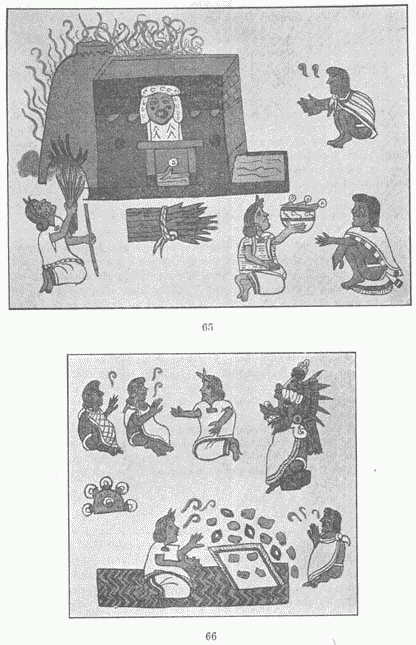
65.
This is a representation of the baths of the Indians, called by them
temezcale. In the picture they have put at the door an Indian who
was an adviser for their sicknesses. When a sick man goes to the bath they
make for him offerings of incense (which they call copale) to
the idol. They hold in veneration the black body of the idol, whom they
call Tezcatepocatl, one of the greater of their gods. They commit in
these baths other foul debaucheries. It is the custom among them for many
men or women to bathe together entirely naked, and there takes place inside
this bath house much foulness and sin.
66.
This is a sort of diabolical leetchcraft which the Indians practice.
When anyone was sick they summon the doctor (man or woman) and then [ask]
the said doctor to see what the outcome of the illness will be. Then they
place in front of the doctor and in front of the sick man an idol, the name
of which idol is Quetzalcoatl, that is, Feather Snake. The doctor
was in the middle, on a mat, and on this mat was placed a mantle of white
cotton. He took in his hand twenty grains of maize (which is the grain from
which they make bread). He throws them upon the mantle as when one throws
dice. If these grains fall so as to leave in the middle an opening or [word
illegible], in such fashion that the grains are all around it, it was a
sign that he would be buried there, that is that he would die of the
disease. If one grain fell upon another the doctor announced that his
disease had come upon him on account of sodomy. If the grains of maize
separated, one half to one side and the other half to the other side, in
such a way that it was possible to draw a straight line through the middle
without touching a single grain, it was a sign that the sickness would
leave the man, and he would get well.
67.
This is another picture, where is shown the way which the Indians have
of doing penance. Namely, they set up on a high place in a seated position
an idol which they call Mictlantecutli, that is, "Lord of the
Dead." Before this idol they sacrifice [blood] from their ears, and
others from their tongues, and others from the calves of their legs. The
method was to thrust through their ears and through their tongues thorns,
very sharp. This was the way they did penance. . . .
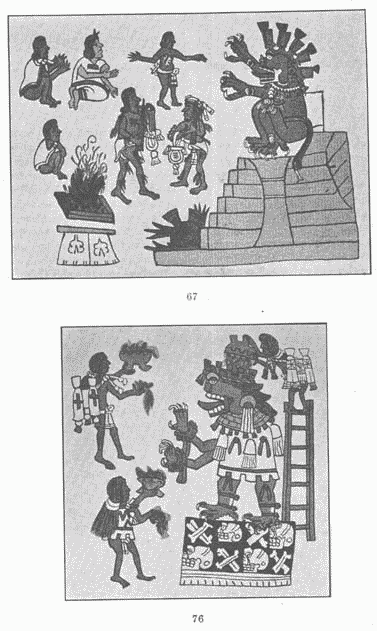
73.
These bundles are bundles of a root (called ocpatli) with
which they make their wine.
This is the woman who carried the wine to the rest until they became
drunk.
76.
This is a demon, much worshipped in their ceremonies, who always has a
great thirst for human blood. Thus on each and every occasion when there
was time and opportunity for him to be worshipped, there might be no
excuses offered. It is to be noted that in addition to the sacrifice to
this demon being performed at all sorts of hours, there was a law that no
one might enter his temple until there had been sacrificed a jar of human
blood; and in addition to this he who came up to offer a sacrifice, had to
hold up his right hand smeared with blood. This they did so that this demon
would be friendly to them at the time of their death. In worshipping him
they place at his feet many skulls and dead bones, signifying that he was
Lord of Death. In offering this blood they put a ladder up behind him, and
climb up on it and pour the blood upon his head, symbolizing thus his
acceptance of it. They pour this sacrifice over his head so that the god
shall not be forgetful at the time of the devotee’s death, of this
sacrifice which he had offered. Having the mouth of the idol open and the
tongue stuck out and bloody signifies that they were never to say that they
did not have a sacrifice which they might offer to him.